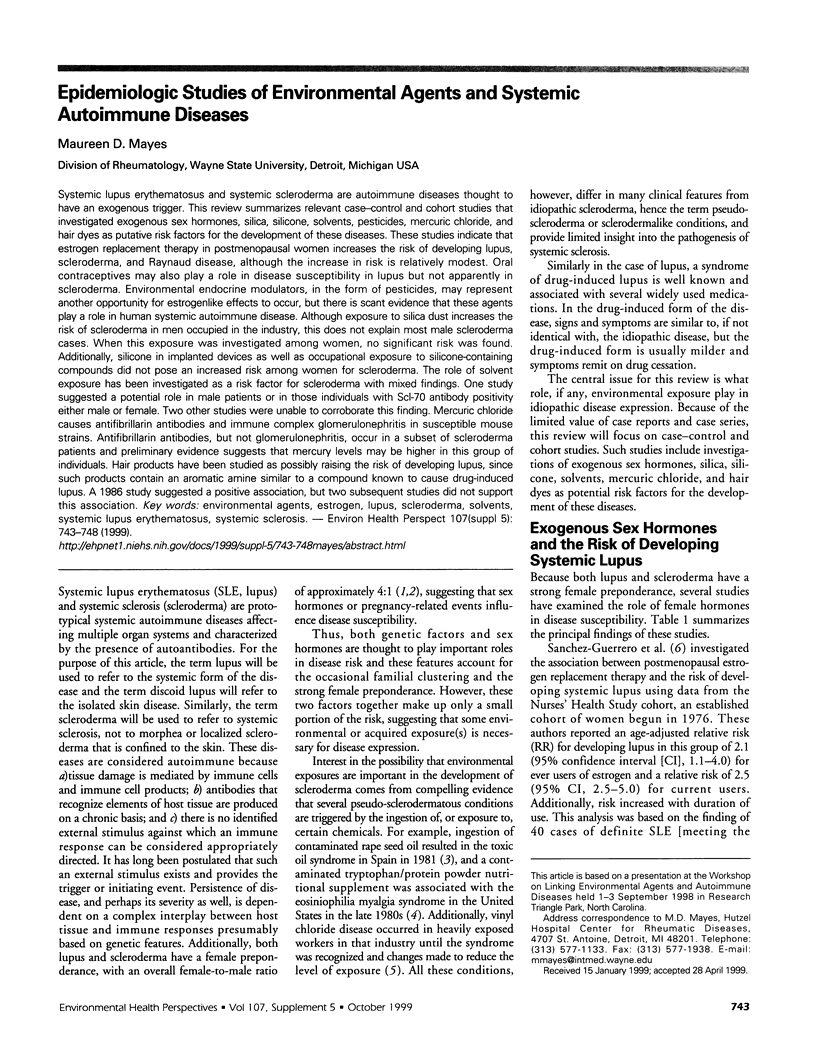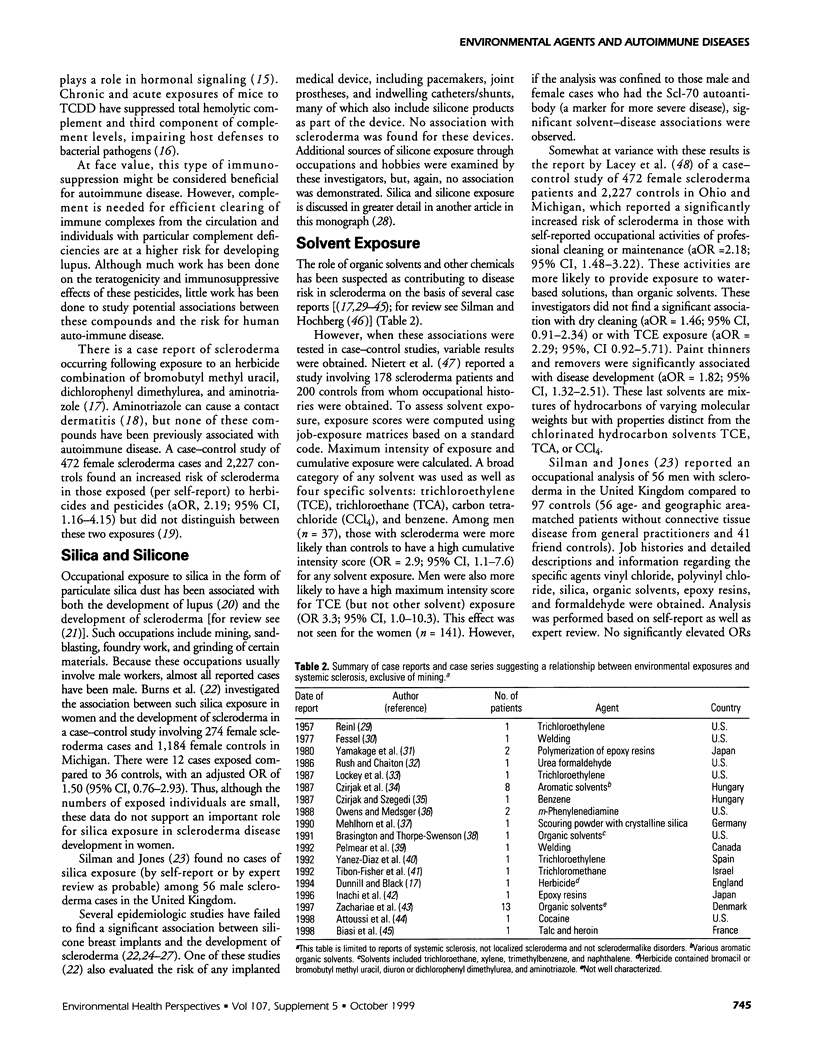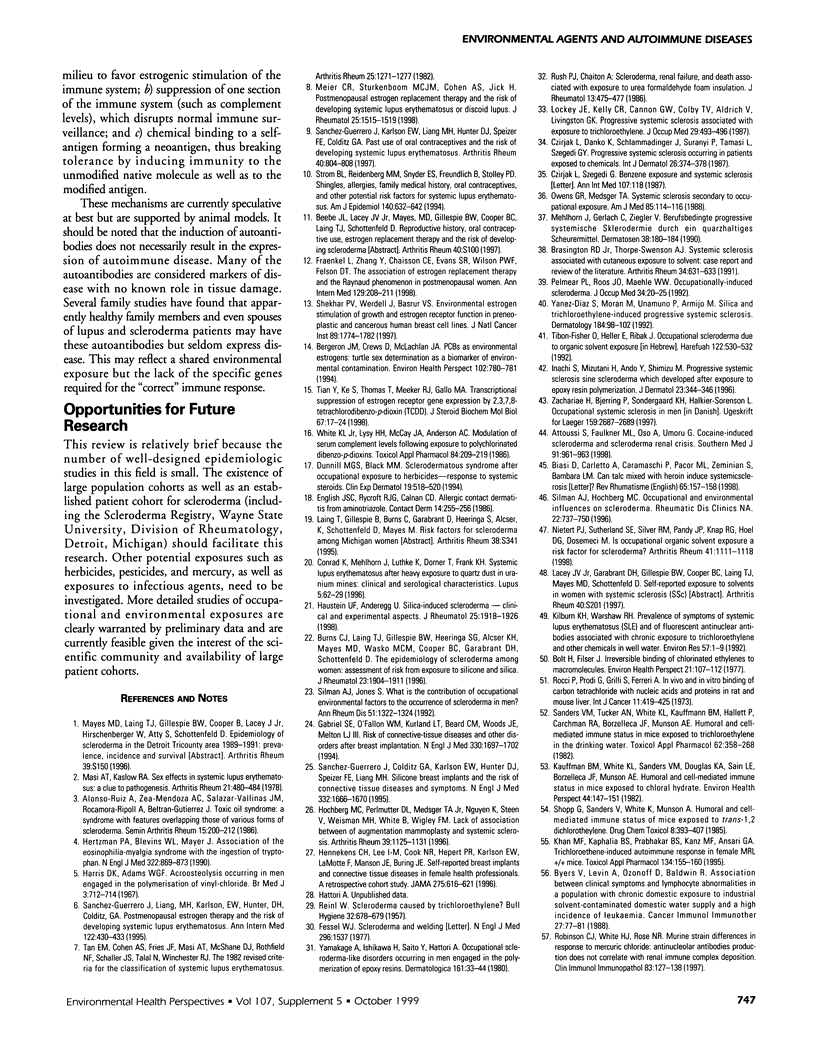Abstract
Systemic lupus erythematosus and systemic scleroderma are autoimmune diseases thought to have an exogenous trigger. This review summarizes relevant case-control and cohort studies that investigated exogenous sex hormones, silica, silicone, solvents, pesticides, mercuric chloride, and hair dyes as putative risk factors for the development of these diseases. These studies indicate that estrogen replacement therapy in postmenopausal women increases the risk of developing lupus, scleroderma, and Raynaud disease, although the increase in risk is relatively modest. Oral contraceptives may also play a role in disease susceptibility in lupus but not apparently in scleroderma. Environmental endocrine modulators, in the form of pesticides, may represent another opportunity for estrogenlike effects to occur, but there is scant evidence that these agents play a role in human systemic autoimmune disease. Although exposure to silica dust increases the risk of scleroderma in men occupied in the industry, this does not explain most male scleroderma cases. When this exposure was investigated among women, no significant risk was found. Additionally, silicone in implanted devices as well as occupational exposure to silicone-containing compounds did not pose an increased risk among women for scleroderma. The role of solvent exposure has been investigated as a risk factor for scleroderma with mixed findings. One study suggested a potential role in male patients or in those individuals with Scl-70 antibody positivity either male or female. Two other studies were unable to corroborate this finding. Mercuric chloride causes antifibrillarin antibodies and immune complex glomerulonephritis in susceptible mouse strains. Antifibrillarin antibodies, but not glomerulonephritis, occur in a subset of scleroderma patients and preliminary evidence suggests that mercury levels may be higher in this group of individuals. Hair products have been studied as possibly raising the risk of developing lupus, since such products contain an aromatic amine similar to a compound known to cause drug-induced lupus. A 1986 study suggested a positive association, but two subsequent studies did not support this association.
Full text
PDF





Selected References
These references are in PubMed. This may not be the complete list of references from this article.
- Alonso-Ruiz A., Zea-Mendoza A. C., Salazar-Vallinas J. M., Rocamora-Ripoll A., Beltrán-Gutiérrez J. Toxic oil syndrome: a syndrome with features overlapping those of various forms of scleroderma. Semin Arthritis Rheum. 1986 Feb;15(3):200–212. doi: 10.1016/0049-0172(86)90017-x. [DOI] [PubMed] [Google Scholar]
- Arnett F. C., Reveille J. D., Goldstein R., Pollard K. M., Leaird K., Smith E. A., Leroy E. C., Fritzler M. J. Autoantibodies to fibrillarin in systemic sclerosis (scleroderma). An immunogenetic, serologic, and clinical analysis. Arthritis Rheum. 1996 Jul;39(7):1151–1160. doi: 10.1002/art.1780390712. [DOI] [PubMed] [Google Scholar]
- Attoussi S., Faulkner M. L., Oso A., Umoru B. Cocaine-induced scleroderma and scleroderma renal crisis. South Med J. 1998 Oct;91(10):961–963. doi: 10.1097/00007611-199810000-00013. [DOI] [PubMed] [Google Scholar]
- Bergeron J. M., Crews D., McLachlan J. A. PCBs as environmental estrogens: turtle sex determination as a biomarker of environmental contamination. Environ Health Perspect. 1994 Sep;102(9):780–781. doi: 10.1289/ehp.94102780. [DOI] [PMC free article] [PubMed] [Google Scholar]
- Biasi D., Carletto A., Caramaschi P., Pacor M. L., Zeminian S., Bambara L. M. Can talc mixed with heroin induce systemic sclerosis? Rev Rhum Engl Ed. 1998 Feb;65(2):157–158. [PubMed] [Google Scholar]
- Bolt H. M., Filser J. G. Irreversible binding of chlorinated ethylenes to macromolecules. Environ Health Perspect. 1977 Dec;21:107–112. doi: 10.1289/ehp.7721107. [DOI] [PMC free article] [PubMed] [Google Scholar]
- Brasington R. D., Jr, Thorpe-Swenson A. J. Systemic sclerosis associated with cutaneous exposure to solvent: case report and review of the literature. Arthritis Rheum. 1991 May;34(5):631–633. doi: 10.1002/art.1780340516. [DOI] [PubMed] [Google Scholar]
- Burns C. J., Laing T. J., Gillespie B. W., Heeringa S. G., Alcser K. H., Mayes M. D., Wasko M. C., Cooper B. C., Garabrant D. H., Schottenfeld D. The epidemiology of scleroderma among women: assessment of risk from exposure to silicone and silica. J Rheumatol. 1996 Nov;23(11):1904–1911. [PubMed] [Google Scholar]
- Byers V. S., Levin A. S., Ozonoff D. M., Baldwin R. W. Association between clinical symptoms and lymphocyte abnormalities in a population with chronic domestic exposure to industrial solvent-contaminated domestic water supply and a high incidence of leukaemia. Cancer Immunol Immunother. 1988;27(1):77–81. doi: 10.1007/BF00205762. [DOI] [PMC free article] [PubMed] [Google Scholar]
- Conrad K., Mehlhorn J., Lüthke K., Dörner T., Frank K. H. Systemic lupus erythematosus after heavy exposure to quartz dust in uranium mines: clinical and serological characteristics. Lupus. 1996 Feb;5(1):62–69. doi: 10.1177/096120339600500112. [DOI] [PubMed] [Google Scholar]
- Czirják L., Dankó K., Schlammadinger J., Surányi P., Tamási L., Szegedi G. Y. Progressive systemic sclerosis occurring in patients exposed to chemicals. Int J Dermatol. 1987 Jul-Aug;26(6):374–378. doi: 10.1111/j.1365-4362.1987.tb00565.x. [DOI] [PubMed] [Google Scholar]
- Czirják L., Szegedi G. Benzene exposure and systemic sclerosis. Ann Intern Med. 1987 Jul;107(1):118–118. doi: 10.7326/0003-4819-107-1-118_2. [DOI] [PubMed] [Google Scholar]
- Dunnill M. G., Black M. M. Sclerodermatous syndrome after occupational exposure to herbicides--response to systemic steroids. Clin Exp Dermatol. 1994 Nov;19(6):518–520. doi: 10.1111/j.1365-2230.1994.tb01262.x. [DOI] [PubMed] [Google Scholar]
- English J. S., Rycroft R. J., Calnan C. D. Allergic contact dermatitis from aminotriazole. Contact Dermatitis. 1986 Apr;14(4):255–256. doi: 10.1111/j.1600-0536.1986.tb01243.x. [DOI] [PubMed] [Google Scholar]
- Fessel W. J. Scleroderma and welding. N Engl J Med. 1977 Jun 30;296(26):1537–1537. doi: 10.1056/NEJM197706302962620. [DOI] [PubMed] [Google Scholar]
- Fraenkel L., Zhang Y., Chaisson C. E., Evans S. R., Wilson P. W., Felson D. T. The association of estrogen replacement therapy and the Raynaud phenomenon in postmenopausal women. Ann Intern Med. 1998 Aug 1;129(3):208–211. doi: 10.7326/0003-4819-129-3-199808010-00009. [DOI] [PubMed] [Google Scholar]
- Freni-Titulaer L. W., Kelley D. B., Grow A. G., McKinley T. W., Arnett F. C., Hochberg M. C. Connective tissue disease in southeastern Georgia: a case-control study of etiologic factors. Am J Epidemiol. 1989 Aug;130(2):404–409. doi: 10.1093/oxfordjournals.aje.a115348. [DOI] [PubMed] [Google Scholar]
- Gabriel S. E., O'Fallon W. M., Kurland L. T., Beard C. M., Woods J. E., Melton L. J., 3rd Risk of connective-tissue diseases and other disorders after breast implantation. N Engl J Med. 1994 Jun 16;330(24):1697–1702. doi: 10.1056/NEJM199406163302401. [DOI] [PubMed] [Google Scholar]
- Hanley G. A., Schiffenbauer J., Sobel E. S. Resistance to HgCl2-induced autoimmunity in haplotype-heterozygous mice is an intrinsic property of B cells. J Immunol. 1998 Aug 15;161(4):1778–1785. [PubMed] [Google Scholar]
- Harris D. K., Adams W. G. Acro-osteolysis occurring in men engaged in the polymerization of vinyl chloride. Br Med J. 1967 Sep 16;3(5567):712–714. doi: 10.1136/bmj.3.5567.712. [DOI] [PMC free article] [PubMed] [Google Scholar]
- Haustein U. F., Anderegg U. Silica induced scleroderma--clinical and experimental aspects. J Rheumatol. 1998 Oct;25(10):1917–1926. [PubMed] [Google Scholar]
- Hennekens C. H., Lee I. M., Cook N. R., Hebert P. R., Karlson E. W., LaMotte F., Manson J. E., Buring J. E. Self-reported breast implants and connective-tissue diseases in female health professionals. A retrospective cohort study. JAMA. 1996 Feb 28;275(8):616–621. [PubMed] [Google Scholar]
- Hertzman P. A., Blevins W. L., Mayer J., Greenfield B., Ting M., Gleich G. J. Association of the eosinophilia-myalgia syndrome with the ingestion of tryptophan. N Engl J Med. 1990 Mar 29;322(13):869–873. doi: 10.1056/NEJM199003293221301. [DOI] [PubMed] [Google Scholar]
- Hochberg M. C., Perlmutter D. L., Medsger T. A., Jr, Nguyen K., Steen V., Weisman M. H., White B., Wigley F. M. Lack of association between augmentation mammoplasty and systemic sclerosis (scleroderma). Arthritis Rheum. 1996 Jul;39(7):1125–1131. doi: 10.1002/art.1780390708. [DOI] [PubMed] [Google Scholar]
- Inachi S., Mizutani H., Ando Y., Shimizu M. Progressive systemic sclerosis sine scleroderma which developed after exposure to epoxy resin polymerization. J Dermatol. 1996 May;23(5):344–346. doi: 10.1111/j.1346-8138.1996.tb04028.x. [DOI] [PubMed] [Google Scholar]
- Kauffmann B. M., White K. L., Jr, Sanders V. M., Douglas K. A., Sain L. E., Borzelleca J. F., Munson A. E. Humoral and cell-mediated immune status in mice exposed to chloral hydrate. Environ Health Perspect. 1982 Apr;44:147–151. doi: 10.1289/ehp.8244147. [DOI] [PMC free article] [PubMed] [Google Scholar]
- Khan M. F., Kaphalia B. S., Prabhakar B. S., Kanz M. F., Ansari G. A. Trichloroethene-induced autoimmune response in female MRL +/+ mice. Toxicol Appl Pharmacol. 1995 Sep;134(1):155–160. doi: 10.1006/taap.1995.1179. [DOI] [PubMed] [Google Scholar]
- Kilburn K. H., Warshaw R. H. Prevalence of symptoms of systemic lupus erythematosus (SLE) and of fluorescent antinuclear antibodies associated with chronic exposure to trichloroethylene and other chemicals in well water. Environ Res. 1992 Feb;57(1):1–9. doi: 10.1016/s0013-9351(05)80014-3. [DOI] [PubMed] [Google Scholar]
- Lockey J. E., Kelly C. R., Cannon G. W., Colby T. V., Aldrich V., Livingston G. K. Progressive systemic sclerosis associated with exposure to trichloroethylene. J Occup Med. 1987 Jun;29(6):493–496. [PubMed] [Google Scholar]
- Masi A. T., Kaslow R. A. Sex effects in systemic lupus erythematosus: a clue to pathogenesis. Arthritis Rheum. 1978 May;21(4):480–484. doi: 10.1002/art.1780210413. [DOI] [PubMed] [Google Scholar]
- Mehlhorn J., Gerlach C., Ziegler V. Berufsbedingte progressive systemische Sklerodermie durch ein quarzhaltiges Scheuermittel. Derm Beruf Umwelt. 1990 Nov-Dec;38(6):180–184. [PubMed] [Google Scholar]
- Meier C. R., Sturkenboom M. C., Cohen A. S., Jick H. Postmenopausal estrogen replacement therapy and the risk of developing systemic lupus erythematosus or discoid lupus. J Rheumatol. 1998 Aug;25(8):1515–1519. [PubMed] [Google Scholar]
- Nietert P. J., Sutherland S. E., Silver R. M., Pandey J. P., Knapp R. G., Hoel D. G., Dosemeci M. Is occupational organic solvent exposure a risk factor for scleroderma? Arthritis Rheum. 1998 Jun;41(6):1111–1118. doi: 10.1002/1529-0131(199806)41:6<1111::AID-ART19>3.0.CO;2-J. [DOI] [PubMed] [Google Scholar]
- Owens G. R., Medsger T. A. Systemic sclerosis secondary to occupational exposure. Am J Med. 1988 Jul;85(1):114–116. doi: 10.1016/0002-9343(88)90515-3. [DOI] [PubMed] [Google Scholar]
- Pelmear P. L., Roos J. O., Maehle W. M. Occupationally-induced scleroderma. J Occup Med. 1992 Jan;34(1):20–25. [PubMed] [Google Scholar]
- Petri M., Allbritton J. Hair product use in systemic lupus erythematosus. A case-control study. Arthritis Rheum. 1992 Jun;35(6):625–629. doi: 10.1002/art.1780350605. [DOI] [PubMed] [Google Scholar]
- Pollard K. M., Lee D. K., Casiano C. A., Bluthner M., Johnston M. M., Tan E. M. The autoimmunity-inducing xenobiotic mercury interacts with the autoantigen fibrillarin and modifies its molecular and antigenic properties. J Immunol. 1997 Apr 1;158(7):3521–3528. [PubMed] [Google Scholar]
- Price E. J., Venables P. J. Drug-induced lupus. Drug Saf. 1995 Apr;12(4):283–290. doi: 10.2165/00002018-199512040-00008. [DOI] [PubMed] [Google Scholar]
- Robinson C. J., White H. J., Rose N. R. Murine strain differences in response to mercuric chloride: antinucleolar antibodies production does not correlate with renal immune complex deposition. Clin Immunol Immunopathol. 1997 May;83(2):127–138. doi: 10.1006/clin.1997.4336. [DOI] [PubMed] [Google Scholar]
- Rocchi P., Prodi G., Grilli S., Ferreri A. M. In vivo and in vitro binding of carbon tetrachloride with nucleic acids and proteins in rat and mouse liver. Int J Cancer. 1973 Mar 15;11(2):419–425. doi: 10.1002/ijc.2910110219. [DOI] [PubMed] [Google Scholar]
- Rush P. J., Chaiton A. Scleroderma, renal failure and death associated with exposure to urea formaldehyde foam insulation. J Rheumatol. 1986 Apr;13(2):475–476. [PubMed] [Google Scholar]
- Sanchez-Guerrero J., Karlson E. W., Liang M. H., Hunter D. J., Speizer F. E., Colditz G. A. Past use of oral contraceptives and the risk of developing systemic lupus erythematosus. Arthritis Rheum. 1997 May;40(5):804–808. doi: 10.1002/art.1780400505. [DOI] [PubMed] [Google Scholar]
- Sanders V. M., Tucker A. N., White K. L., Jr, Kauffmann B. M., Hallett P., Carchman R. A., Borzelleca J. F., Munson A. E. Humoral and cell-mediated immune status in mice exposed to trichloroethylene in the drinking water. Toxicol Appl Pharmacol. 1982 Mar 15;62(3):358–368. doi: 10.1016/0041-008x(82)90138-7. [DOI] [PubMed] [Google Scholar]
- Shekhar P. V., Werdell J., Basrur V. S. Environmental estrogen stimulation of growth and estrogen receptor function in preneoplastic and cancerous human breast cell lines. J Natl Cancer Inst. 1997 Dec 3;89(23):1774–1782. doi: 10.1093/jnci/89.23.1774. [DOI] [PubMed] [Google Scholar]
- Shopp G. M., Jr, Sanders V. M., White K. L., Jr, Munson A. E. Humoral and cell-mediated immune status of mice exposed to trans-1,2-dichloroethylene. Drug Chem Toxicol. 1985;8(5):393–407. doi: 10.3109/01480548509041066. [DOI] [PubMed] [Google Scholar]
- Silman A. J., Hochberg M. C. Occupational and environmental influences on scleroderma. Rheum Dis Clin North Am. 1996 Nov;22(4):737–749. doi: 10.1016/s0889-857x(05)70298-2. [DOI] [PubMed] [Google Scholar]
- Silman A. J., Jones S. What is the contribution of occupational environmental factors to the occurrence of scleroderma in men? Ann Rheum Dis. 1992 Dec;51(12):1322–1324. doi: 10.1136/ard.51.12.1322. [DOI] [PMC free article] [PubMed] [Google Scholar]
- Strom B. L., Reidenberg M. M., West S., Snyder E. S., Freundlich B., Stolley P. D. Shingles, allergies, family medical history, oral contraceptives, and other potential risk factors for systemic lupus erythematosus. Am J Epidemiol. 1994 Oct 1;140(7):632–642. doi: 10.1093/oxfordjournals.aje.a117302. [DOI] [PubMed] [Google Scholar]
- Sánchez-Guerrero J., Colditz G. A., Karlson E. W., Hunter D. J., Speizer F. E., Liang M. H. Silicone breast implants and the risk of connective-tissue diseases and symptoms. N Engl J Med. 1995 Jun 22;332(25):1666–1670. doi: 10.1056/NEJM199506223322502. [DOI] [PubMed] [Google Scholar]
- Sánchez-Guerrero J., Karlson E. W., Colditz G. A., Hunter D. J., Speizer F. E., Liang M. H. Hair dye use and the risk of developing systemic lupus erythematosus. Arthritis Rheum. 1996 Apr;39(4):657–662. doi: 10.1002/art.1780390418. [DOI] [PubMed] [Google Scholar]
- Sánchez-Guerrero J., Liang M. H., Karlson E. W., Hunter D. J., Colditz G. A. Postmenopausal estrogen therapy and the risk for developing systemic lupus erythematosus. Ann Intern Med. 1995 Mar 15;122(6):430–433. doi: 10.7326/0003-4819-122-6-199503150-00005. [DOI] [PubMed] [Google Scholar]
- Tan E. M., Cohen A. S., Fries J. F., Masi A. T., McShane D. J., Rothfield N. F., Schaller J. G., Talal N., Winchester R. J. The 1982 revised criteria for the classification of systemic lupus erythematosus. Arthritis Rheum. 1982 Nov;25(11):1271–1277. doi: 10.1002/art.1780251101. [DOI] [PubMed] [Google Scholar]
- Tian Y., Ke S., Thomas T., Meeker R. J., Gallo M. A. Transcriptional suppression of estrogen receptor gene expression by 2,3,7,8-tetrachlorodibenzo-p-dioxin (TCDD). J Steroid Biochem Mol Biol. 1998 Oct;67(1):17–24. doi: 10.1016/s0960-0760(98)00067-3. [DOI] [PubMed] [Google Scholar]
- Tibon-Fisher O., Heller E., Ribak J. [Occupational scleroderma due to organic solvent exposure]. Harefuah. 1992 Apr 15;122(8):530-2, 551. [PubMed] [Google Scholar]
- White K. L., Jr, Lysy H. H., McCay J. A., Anderson A. C. Modulation of serum complement levels following exposure to polychlorinated dibenzo-p-dioxins. Toxicol Appl Pharmacol. 1986 Jun 30;84(2):209–219. doi: 10.1016/0041-008x(86)90128-6. [DOI] [PubMed] [Google Scholar]
- Yamakage A., Ishikawa H., Saito Y., Hattori A. Occupational scleroderma-like disorder occurring in men engaged in the polymerization of epoxy resins. Dermatologica. 1980;161(1):33–44. doi: 10.1159/000250328. [DOI] [PubMed] [Google Scholar]
- Yáez Díaz S., Morán M., Unamuno P., Armijo M. Silica and trichloroethylene-induced progressive systemic sclerosis. Dermatology. 1992;184(2):98–102. doi: 10.1159/000247513. [DOI] [PubMed] [Google Scholar]


